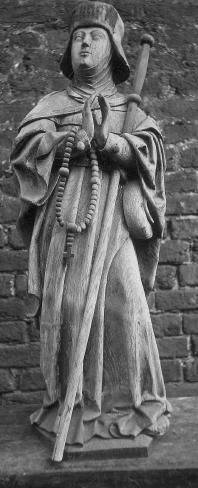Reineldis
Saint Reineldis | |
|---|---|
 Saint Reineldis as a pilgrim to the Holy Land, by the Master of Elsloo, circa 1530 | |
| Virgin and Martyr | |
| Born | c. 630 Condacum |
| Died | c. 700 Saintes, Brabant, Belgium |
| Major shrine | Saintes, where her relics are kept |
| Feast | 16 July |
| Attributes | sword or pilgrim's staff |
| Patronage | open wounds, against eye diseases |
Reineldis (also Reinhild, Reinaldes, Rainelde among others; c. 630 – c. 700) was a saint of the 7th century, martyred by the Huns.
Life
Reineldis was born in a place called Condacum (which is identified with either Condé-sur-l'Escaut or Kontich). She was the daughter of Duke Witger of Lotharingia and Saint Amalberga of Maubeuge. Her brother Emebert was a priest in the diocese of Cambrai. Her biography mentions Gudula as her sister. Her mother entered the religious life at Maubeuge Abbey.
Reineldis made a pilgrimage to the Holy Land. Her vita, written between 1048–1051 in Lobbes Abbey,[1] records this fact, stating that she visited Jerusalem.
She returned home and devoted herself to a life of charitable work at Saintes.[2] She was decapitated by the Huns at Saintes, together with deacon Grimoaldus and her servant Gondulphus.
Veneration
Saint Reineldis is primarily venerated in Saintes as the patron saint of the town. Some sources even indicate that Saintes owes its name to Reineldis' martyrdom.[3]
The parish church of Saintes is dedicated to Sainte-Renelde since the Middle Ages and has preserved the relics of Saint Reineldis. This church has a large bell tower built in the 17th century.[4][5]
Saint Reineldis' patronage for eye diseases is due to the association with a water well in Saintes known as "Sainte Renelde's well", water which is believed to cure eye diseases.[4][6]
Iconography
Reineldis is commonly depicted with a sword or being dragged by her hair, referring to the decapitation. She is also portrayed as a pilgrim, because of her journey to the Holy Land.
Gallery
-
The Saint Reineldis church (1553) in Saintes (Belgium).
-
The Saint Reineldis fountain (1861) in Saintes (Belgium).
Notes
- ^ Vita Reineldis, Acta Sanctorum, Julii IV, 173-178.
- ^ Rabenstein, Katherine (July 1998). "Reineldis". Saints O' the Day for July 16. Archived from the original on February 6, 2007. Retrieved 2012-02-23.
{{cite web}}: CS1 maint: unfit URL (link) - ^ "Tubize". Communes of Brabant Wallon. Expatriate Online: Your Bookmark to Belgium. Archived from the original on 2006-11-12. Retrieved 2007-02-21.
- ^ a b "Stocks, Relics and... 'Tarte al Djote'". Office de Promotion du Tourisme de Wallonie et de Bruxelles. June 2006. Archived from the original on 2007-09-27. Retrieved 2007-02-21.
- ^ "Villers-la-Ville, Rebecq and Tubize". Living in Belgium. 2005. Retrieved 2007-02-21.
- ^ "Sainte Renelde et comp". Nominis. Retrieved 2007-02-21.
External links
- (in Norwegian) Den hellige Reineldis
- (in French) Pictures of Saintes, Belgium - includes both the church (eglise) and well (puits) of Saint Reineldis
- Catholic Online entry for Reineldis


